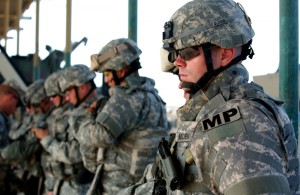
Missouri Governor to Send More Troops After Violence Flares in Ferguson
FERGUSON, Mo. — With this St. Louis suburb reeling from a chaotic night of demonstrations that erupted in many fires, frequent bursts of gunshots, looting and waves of tear gas, Gov. Jay Nixon said early Tuesday that he would send additional National Guard troops to help quell the worst violence this battered city has seen since a white police officer shot and killed an unarmed black teenager in August.
The hours of unrest followed the announcement on Monday evening that a grand jury had chosen not to indict the officer, Darren Wilson, for the death of Michael Brown. St. Louis County reported that 61 people had been arrested.
“I really don’t have any hesitation in telling you that I didn’t see a lot of peaceful protest out there tonight, and I’m disappointed about that,” Jon Belmar, the St. Louis County police chief, said early Tuesday at a news conference. “I’m not saying there weren’t folks out there that were out there for the right reason — I’m not saying that wasn’t the case — but I am saying that, unfortunately, this spun out of control.”
Chief Belmar said demonstrators had set fire to at least a dozen buildings in and around Ferguson, and estimated that he had heard about 150 gunshots. The police, he said, did not fire any live ammunition.
Asked whether he would call the unrest that unfolded in Ferguson a riot, the chief replied, “Oh yeah, this fits.”
Fires continued to burn into Tuesday, and some of the flames and smoke on West Florissant Avenue, a main thoroughfare that was an epicenter of violence in August, lapped over the fence lines behind the storefronts, swooping perilously close to homes.
“It’s horrible, horrible, horrible, horrible,” said Tammy Ruffin, 54, standing in stinging smoke that swept over her house Tuesday morning. “I knew this was going to happen.”
Although she said that she, too, was upset that Officer Wilson had not been indicted, “It’s the wrong reaction,” she said.
The outbreak of violence played out even as President Obama spoke from the White House and pleaded for calm and restraint from both the police and the protesters.
“First and foremost, we are a nation built on the rule of law,” Mr. Obama said. “And so we need to accept that this decision was the grand jury’s to make.”
Speaking at a news conference in Clayton, Mo., Robert P. McCulloch, the St. Louis County prosecuting attorney, described the series of events that led to the shooting, as well as the evidence presented to the 12-member grand jury. He detailed an altercation inside Officer Wilson’s vehicle, after which Officer Wilson had Mr. Brown’s blood on his weapon, shirt and pants, the prosecutor said, as well as swelling and redness on his face.
But the words spoken by Mr. Obama and Mr. McCulloch seemed distant here on a night when screams and gunshots echoed through the streets, demonstrators looted stores and set vehicles ablaze, and officers were pelted with rocks and bricks. Demonstrations also played out across the country, including in Atlanta; Los Angeles; New York; Oakland, Calif.; and Philadelphia. The demonstrations were largely peaceful.
In Ferguson, the unrest that began outside the police station quickly spread through other parts of the city and region, as people braved chilly temperatures to take to the streets. In St. Louis, protesters shuttered Interstate 44 and marched along Grand Boulevard in the southern part of the city.
Disorder broke out moments after Mr. McCulloch announced that Mr. Wilson would not face charges for the Aug. 9 shooting.
Mr. Brown’s mother, Lesley McSpadden, and stepfather, Louis Head, stood with protesters outside the barricaded Ferguson police station as Mr. McCulloch made the decision public. As Ms. McSpadden cried, Mr. Head turned and yelled, with an expletive injected, “Burn this down!”
The crowd began to roar, and some demonstrators rushed toward a fence near which police officers had assembled.
“You need to disperse,” a voice over the loudspeaker of an armored police vehicle said after protesters threw rocks at officers, vandalized buildings and set fire to a police squad car. “Leave the area immediately.”
Almost on cue, right after Mr. McCulloch said that Officer Wilson would not be charged, cars began flooding what was an empty West Florissant Avenue. Outraged pedestrians foretold the volatility that ensued.
As the unrest began in some parts of Ferguson, the police initially held back. On West Florissant, demonstrators shattered windows at a McDonald’s restaurant and a wireless phone store, and they removed wooden boards that were intended to protect a liquor store.
But the police eventually returned to the streets with significant force. As the authorities regained control of most of West Florissant, they formed a line with armored vehicles to restrict access and threatened to arrest those who remained on the street.
“You need to stop destroying the city of Ferguson,” an officer said over a loudspeaker.
Chief Belmar said the initial, hands-off tactics by the police were intended to allow protesters to stage peaceful demonstrations, but he said that the situation ultimately grew so unstable that it required a more forceful approach.
But Rev. Waltrina Middleton, who traveled here from Chicago to help maintain peace, blamed the police for aggression. “I think they’re going over the top,” she said. “A lot of what you see is a response to the aggressive nature of the police.”
A variety of businesses in the Ferguson area, including nail shops, a Walgreens and a public storage facility, went up in flames. Firefighters, the police said, could not easily reach burning businesses because the conditions were too dangerous.
Gunfire rang out frequently throughout the night — sometimes sounding like it came from an automatic weapon — forcing protesters and reporters along the strip to rush for cover.
The scenes of fire and smoke throughout the city were both intimidating and captivating to residents of the area. Mike Jones, 30, who lives on the north side of St. Louis, said he was watching the events unfold from his home but then raced out to assess the situation in person. He had mixed feelings about what he saw. The black community needed to take a stand, he said, but the looting and fires only take money away from people.
“People, they’re only able to express themselves so many ways,” said Mr. Jones, who is black. “It’s never a win-win situation.”
In a terse statement issued just after 1 a.m., the office of Mr. Nixon, who visited Ferguson hours before the grand jury’s announcement, said the governor had ordered more members of the National Guard into the city, but did not specify how many.
“The Guard is providing security at the Ferguson Police Department, which will allow additional law enforcement officers to protect the public,” the statement said.
On Monday night, National Guard soldiers had been assigned to protect, among other locations, a police command post and an electrical substation. That approach, though, frustrated Ferguson’s mayor, James Knowles III, as the unrest spread.
“They’re here in the area,” Mr. Knowles said, “I don’t know why they’re not deploying.”
It remained unclear what other steps the authorities would take to manage protests that were expected to continue. Earlier this year, Mr. Nixon briefly imposed a midnight curfew in Ferguson.
Captain Ronald S. Johnson of the Missouri State Highway Patrol, one of the commanders overseeing the police response, deflected a question about whether Missouri officials might reinstate a curfew.
Source: NY Times




